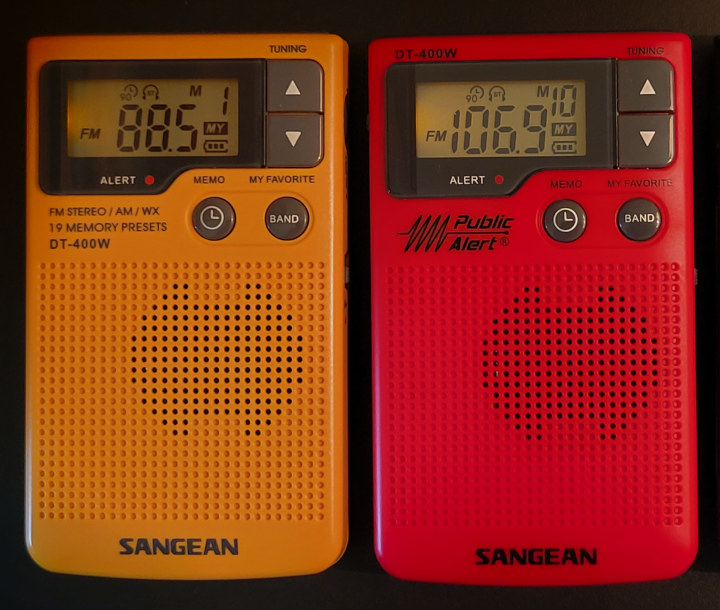
This is the first time I've felt that I needed to rewrite a review entirely. That's good news. But, first, let's describe the subject of this review, the Sangean DT-400W radio.
The DT-400W is a pocket-sized radio that receives stations on the AM band, the FM band, and the seven channels above 162 MHz dedicated to National Weather Service broadcasts. I bought my first DT-400W in May 2010, and reviewed it in 2011. That's the yellow one in the picture above. In July 2021, I bought a "limited edition" DT-400W, the red one in the picture above. That radio was denoted as a "limited edition" radio because Sangean sold it in a red cabinet as well as the usual yellow color. As best as I've been able to determine, this is something Sangean did during 2020, but the radio was available the following year as well.
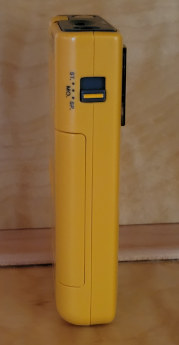
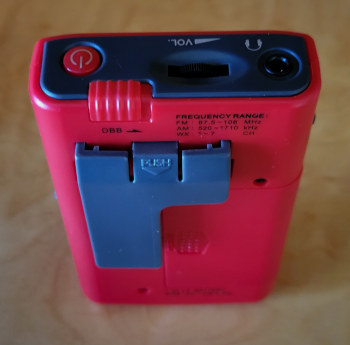
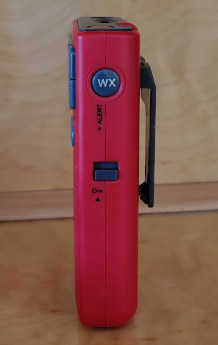
While basic, the DT-400W has easy-to-use controls and a couple of features that are useful. The picture on the far left shows the switch that selects among three options: listening through the built-in speaker, headphone listening in mono, or headphone listening in stereo. Effectively, this allows FM stereo reception to be shut off, which can be useful for making weak signals more listenable.
The DT-400W also has a bass boost feature, as do many other portable Sangean models. That switch is on top of the radio, shown at middle left. The bass enhancement, called Dynamic Bass Boost (DBB), works with both the speaker and with headphone listening. The speaker is small, so you're not going to get booming audio by any means. But activating DBB can make listening through the 1 3/8" speaker more pleasant. Even without DBB, the radio has a pleasant, balanced sound when listening through headphones.
For FM and weather-band reception when using the speaker, the DT-400W comes with a wire that plugs into the headphone jack. That wire serves as an antenna. It's a bit more than 33 inches long, slightly too long for optimal FM reception, but an antenna that's a little too long is better than one that's too short, which is something all too common on portable radios. For weather-band and FM reception while using headphones, the radio uses the headphone cord as the antenna, and so results may vary depending upon the length of the headphone cord.
On the right side of the radio, there is a lock switch (pictured at near left) that can prevent accidentally turning the radio on, or any changes to controls when the radio is on. The button to select weather-band reception, labeled WX is also on this side of the unit.
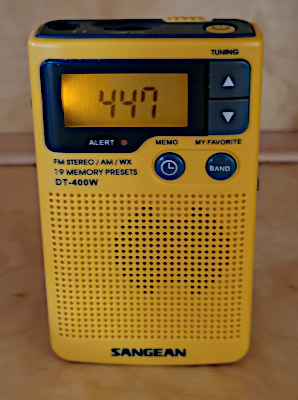
There's also a 90-minute sleep timer, which comes on by default. It can be defeated by holding down the power button when first turning on the unit.
A yellow backlight for the LCD display comes on when any of the controls are pressed. This is true even when the radio is off, if the lock switch isn't on. Unfortunately, there is no signal-strength indicator in the display: just the station frequency and band, plus an indicator of stereo reception on FM and an indicator to tell you that the sleep timer is on.
When the radio is off, a clock displays (see picture at right). However, the DT-400W does not have an alarm feature.
As with the physically similar DT-200VX and DT-250 models, the DT-400W takes two "AA" batteries. The battery compartment door is hinged, just as on those other models. There is no connection available for AC power.
Up to 19 AM or FM stations can be set in memory. Those stations can be conveniently tuned with the "My Favorites" feature, which essentially acts as another band on the radio, with memory positions accessed with the up and down tuning buttons. Otherwise, the up and down buttons tune 100 kHz at a time on FM, and 9 or 10 kHz at a time on AM. (In the Western Hemisphere, 10 kHz tuning steps are used on the AM band. The DT-400W can be set for either 9 or 10 kHz tuning steps when the radio is off by pressing the power button and the up button or the down button at the same time.) The "Band" button on the radio selects between the AM band, the FM band, and My Favorites.
The DT-400W can tune all seven channels on the special VHF band that's reserved for National Weather Service broadcasts. An article in the May 1973 issue of Popular Electronics explained that the special weather-radio service had its origins in Chicago in the early 1950's, expanding to Kansas City and New York City by 1962. By 1973, there were around 60 stations. There are now more than 1,000. Environment Canada operates a similar service in that country. There are six stations serving parts of the San Francisco Bay Area. The overlapping coverage is necessary because of the difficult terrain that blocks signals.
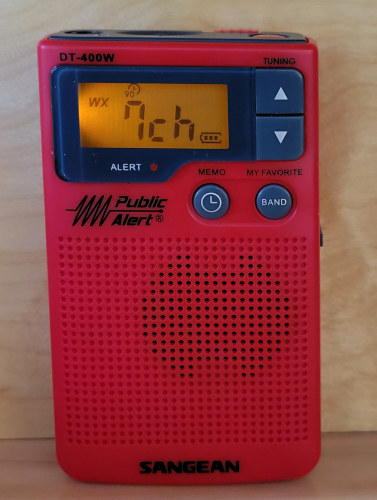
The weather band is selected by pressing the WX button on the right side of the radio. The display shows one of the seven weather-band channel numbers, rather than the actual frequency. Weather band stations are located every 25 kHz between 162.4 and 162.55 MHz.
Holding the WX button down allows the use of its alerting feature. In the event of a weather warning, the Weather Service sends out a 1050 Hz tone that will activate specially equipped radios. This is one of the requirements for radios labeled as a Public Alert device. The newer version of the DT-400W has this label. The older version also has the alert feature.
The DT-400W's alert feature can be set to be on for 4, 8, or 12 hours at a time. However, reports indicate that being on stand-by for alerts causes a significant drain on the unit's batteries. I've never used the alert feature, because it's something that would rarely be used in the Bay Area. The situation is probably different in much of the rest of the United States or Canada.
Weather-band performance on the older version of the DT-400W is excellent. At my East Bay location, depending upon reception conditions, I could pick up five or all six of the weather-radio stations serving the Bay Area. A couple of those signals were weak, but still readable. That's the best performance of any of the weather radios that I've had.
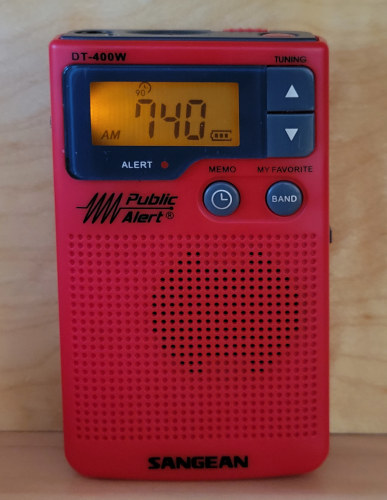
The older version of the DT-400W featured unusually noise-free AM performance. When I first got the radio, I tested it out the noisy, computer-filled San Francisco office that I had at the time. That was an environment that defeated most AM radios, but not this one: I could get clear, clean audio from KCBS and KGO, two local 50,000-watt powerhouses. Other local stations had some noise but could at least be heard.
The newer version is even more noise-resistant. There are multiple sources of AM-band interference in my house, as there are in many houses. The newer DT-400 was less prone to picking up that interference even compared to the older DT-400. The actual number of AM stations received is similar, around 30 at my location.
Now we come to the aspect of the DT-400W that caused me to write a new review to replace the one that had been in Radios I Have Known: the DT-400W's FM performance is much improved in the newer version!
I don't know when Sangean upgraded the DT-400W's FM capabilities. I have gone back through other online reviews of this model, which seem to indicate that improvements occurred in the mid-2010s. Improvement was certainly called for. The older version of the DT-400W had what I would call mediocre FM performance at best. It wasn't selective on FM. HD radio sidebands were a particularly pesky source of interference. Strong signals would wipe out stations even three channels away. As an example, quite a few San José and South Bay FM stations are on channels midway between two San Francisco stations. The older version of the DT-400W can't receive those stations. The newer version can!
FM performance for the newer version of the DT-400W is now comparable to the excellent performance of the DT-250 model that's sold outside North America. In fact, when I got the DT-250 in July 2021, I was pleasantly surprised by the much improved performance of the DT-250, compared to the older DT-400W and the DT-200VX from 2009. That's when I started looking for the newer version of the DT-400W, and found that the "limited edition" with the red cabinet was still available. It was an unexpected bonus to get yet another cabinet color to match the yellow of the older version, the silver of the DT-250, and the black of the DT-200VX.
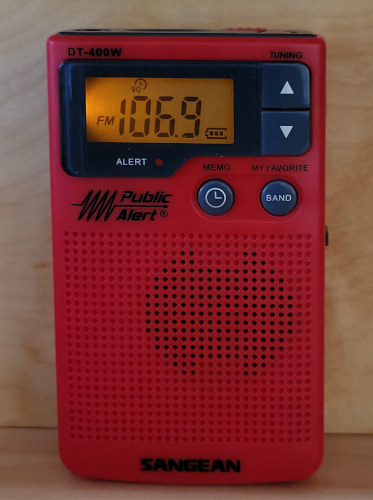
A simple set of station counts tells a good part of the story about the newer version's much-improved FM performance.
- DT-250: 49 FM stations
- New DT-400W: 50 FM stations
- Older DT-400W: 31 FM stations
That was the first comparison that I did. I had a hard time believing it! So, on another day, I did another comparison. One station that normally is present on most radios at my location was off the air that day. The resulting counts are consistent with the first ones!
- DT-250: 48 stations
- New DT-400W: 49 stations
- Older DT-400W: 25 stations
Note that these counts include four or so marginal signals that were steady but weak. I didn't count signals that faded in and out rapidly. I also didn't count the number of stations received in stereo.
Is the newer version of the DT-400W a DSP-based radio? The package for my DT-250 says it is a DSP-based radio, but the DT-400W package just says it has a PLL-synthesized tuner. Yet the performance of the two models is nearly identical. The DT-400W also shows no sign of front-end overload whatsoever, which would be unusual (though possible) in a non-DSP receiver. I believe the newer DT-400W is DSP-based, but I have no definitive evidence to support that conclusion. There is no sign of "soft muting" of very weak signals with either model, a controversial feature which is often in evidence on DSP-based radios.
It's interesting to note that the newer version of the DT-400W appeared to be slightly less sensitive on the weather band compared to the older version, with only five of the seven stations on the Bay Area being received. One of those five was very weak and barely audible. Still, the DT-400W, whether the older version or the newer version, is one of the best-performing weather-band receivers I've encountered.
Overall, this is a well-designed radio that's especially good on the weather band, good on AM, and now excellent on FM. Make sure you get a model that has the "Public Alert" label. Another way of ensuring that you have the updated model is to look at the date code, shown on a label that's on the inside of the battery door. The date code starts with two letters followed by a series of numbers. The first two numbers indicate the year that the radio was made; for example, "18" for "2018". That appears to be the first year that Sangean put a label with the date code on its products. The red DT-400W that I have was manufactured in 2018.
Just to make sure that the improved reception of the DT-400W in the red case wasn't a fluke, I got a newer version of the yellow DT-400W, which performed identically to the updated red models. Its date code indicated that it was made in 2020.
In 2011, I wrote, "How could the radio be improved? Better FM reception to start with, and the ability either to stand up or the addition of a stand." Sangean has taken care of the FM improvements, that's for sure. Now they should get to work on a stand for the radio. A signal-strength indicator would be nice, too, but the current version of the display doesn't really have room for one.
For $60 to $65, the price range in 2021, the DT-400W represents very good value with a well-chosen set of features. It was especially encouraging to see that Sangean fixed the one major deficiency with the original version of this model, with its FM reception capabilities now among the best in its class.